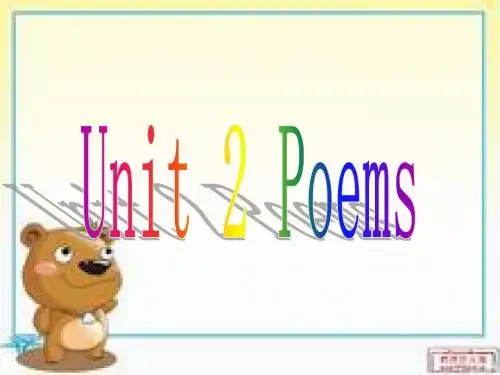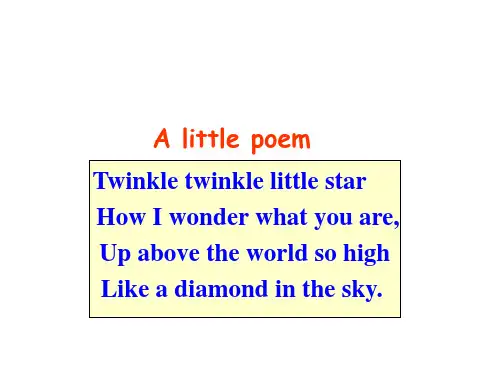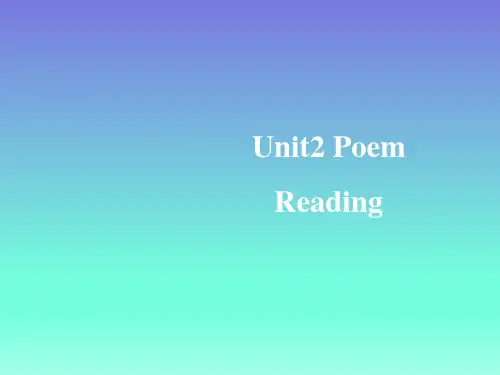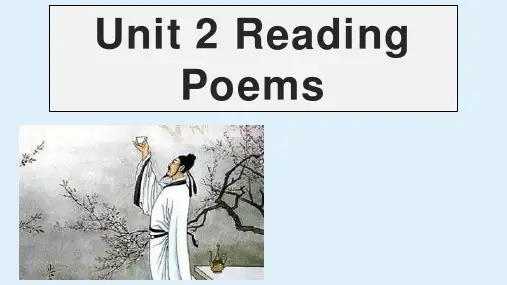英语人教版选修六unit2_reading
- 格式:ppt
- 大小:1.65 MB
- 文档页数:31



![新人教版选修六 Unit 2 Poem Extensive reading[课件]](https://uimg.taocdn.com/558531156bd97f192279e99e.webp)







高中英语学习材料(灿若寒星*制作整理)Book 6 Unit 2 PoemsPre-reading activitiesTask I. Read the following little poems and pay attention to the pronunciation of the last word of each line.AI am coming, little maiden,With the pleasant sunshine ladenWith the honey for the bee,With the blossom for the tree.BTwinkle, twinkle, little star,How I wonder what you are!Up above the world so high,Like a diamond in the sky.Task II. Choose the correct definition according to the explanations.rhythm, syllable, rhyme, pattern1. ________ a part of a word that contains a single vowel sound and that is pronounced as a unit2. ________ a pattern formed by stressed and unstressed syllables in words3. ________ a repetition of similar sounds in two or more words, most often in the final syllablesof lines in poems and songs4. ________ the repeated or regular way in which something happens or is doneWhile-reading activitiesTask I. Read the parts of the text describing different forms of poetry and fill in the blanks in the chart, getting to know the different patterns of each kind of poem.Task II. Read Poems A and B and find out the rhyming word for the following words:word ________ sing ________ brass ________ broke ________ away ________fire ________ high ________ lead ________ race ________ cat ________ too ________Task III. In Poems A, B and C, there are some repeated phrases. Please pick them out._______________________________________________________________________________ Task IV. Fill in the blanks.In Poems B and C, the line length is changing. In Poem B, the shortest line has 1. ________ words while the longest line has 2. ________ words. In Poem C, the shortest line has 3. ________ words while the longest line has 4. ________ words.Task V. Read Poems F and G and divide the 17 syllables.A fallen blossomIs coming back to the branch.Look, a butterfly!Snow having melted, The whole village is brimful Of happy children.Post-reading activitiesTask I. Below is a summary of the text with some words missing. Choose the words from the box and make the summary complete. Then try to retell the text to your partners.playing with, Tang, Nursery rhymes, Japanese, line lengths, five, rhythmPoets use many forms of poems to describe something. Here are some simple ones. 1. ________ are a common type of children’s poetry. Children like them because they rhyme, have 2. ________ and say things over and over again. They don’t have to make sense because children learn about language by 3. ________ words. List poems have different 4. ________. The repetition in them though gives them rhythm and a pattern. Cinquains are made up of 5. ________ lines and can create a strong picture with few words. Although Haiku is a(n) 6. ________ form of poetry, it is popular with English writers because, like the cinquain, it too can create a strong picture with few words. English speakers also enjoy other forms of Asian poetry, especially Chinese 7. ________ poems. Many students may want to try and write some poems of their own. Why not have a go? It’s worth it! (By Ray Cama)Task II. Choose one of the poems that you like most and read it aloud in your group. Tell your group members why you like it.Task III. Change Poems D and E into two short stories, then tell them in your own words in your group.Task IV. Draw two pictures according to Poems F and G.Task V. Try to find the Chinese version of Poem H, and read it aloud in both English and Chinese to your group members. Pay attention to the rhymes and rhythms of the poem. Keys:Pre-reading activitiesTask II. 1. syllable 2. rhythm 3. rhyme 4. patternWhile-reading activitiesTask I.1. rhythm2. recite3. length4. phrases5. five6. picture7. 178. feelingTask II.mockingbird; ring; looking-glass; billy-goat; todaysquire; sky; dead; lace; hat; trueTask III. Papa’s going to buy you;I saw;if we hadTask IV. 1. 6 2. 8 3. 4 4. 10Task V.A fall-en blos-som is com-ing back to the branch. Look, a but-ter-fly!Snow hav-ing melt-ed, the whole vil-lage is brim-ful of hap-py chil-dren.Post-reading activitiesTask I. 1. Nursery rhymes 2. rhymes 3. playing with 4. line lengths 5. five 6. Japanese 7. TangTask II. 略Task III.Poem DMy brother is handsome and full of energy. Sometimes he makes fun of me, shouting at me and laughing at me. He is both my friend and my enemy.Poem EIn hot summer, I feel sleepy and I’m sweating all the time. I’m feeling weak and scared in the dry weather. It lasts week after week endlessly.Task IV. 略Task V. 略。
Book 6 Unit 2 PoemsPre-reading activitiesTask I. Read the following little poems and pay attention to the pronunciation of the last word of each line.AI am coming, little maiden,With the pleasant sunshine ladenWith the honey for the bee,With the blossom for the tree.BTwinkle, twinkle, little star,How I wonder what you are!Up above the world so high,Like a diamond in the sky.Task II. Choose the correct definition according to the explanations.rhythm, syllable, rhyme, pattern1. ________ a part of a word that contains a single vowel sound and that is pronounced as a unit2. ________ a pattern formed by stressed and unstressed syllables in words3. ________ a repetition of similar sounds in two or more words, most often in the final syllablesof lines in poems and songs4. ________ the repeated or regular way in which something happens or is doneWhile-reading activitiesTask I. Read the parts of the text describing different forms of poetry and fill in the blanks in the chart, getting to know the different patterns of each kind of poem.Task II. Read Poems A and B and find out the rhyming word for the following words:word ________ sing ________ brass ________ broke ________ away ________fire ________ high ________ lead ________ race ________ cat ________ too ________Task III. In Poems A, B and C, there are some repeated phrases. Please pick them out._______________________________________________________________________________ Task IV. Fill in the blanks.In Poems B and C, the line length is changing. In Poem B, the shortest line has 1. ________ words while the longest line has 2. ________ words. In Poem C, the shortest line has 3. ________words while the longest line has 4. ________ words.Task V. Read Poems F and G and divide the 17 syllables.A fallen blossomIs coming back to the branch.Look, a butterfly!Snow having melted, The whole village is brimful Of happy children.Post-reading activitiesTask I. Below is a summary of the text with some words missing. Choose the words from the box and make the summary complete. Then try to retell the text to your partners.playing with, Tang, Nursery rhymes, Japanese, line lengths, five, rhythmPoets use many forms of poems to describe something. Here are some simple ones. 1. ________ are a common type of children’s poetry. Children like them because they rhyme, have 2. ________ and say things over and over again. They don’t have to make sense because children learn about language by 3. ________ words. List poems have different 4. ________. The repetition in them though gives them rhythm and a pattern. Cinquains are made up of 5. ________ lines and can create a strong picture with few words. Although Haiku is a(n) 6. ________ form of poetry, it is popular with English writers because, like the cinquain, it too can create a strong picture with few words. English speakers also enjoy other forms of Asian poetry, especially Chinese 7. ________ poems. Many students may want to try and write some poems of their own. Why not have a go? It’s worth it! (By Ray Cama)Task II. Choose one of the poems that you like most and read it aloud in your group. Tell your group members why you like it.Task III. Change Poems D and E into two short stories, then tell them in your own words in your group.Task IV. Draw two pictures according to Poems F and G.Task V. Try to find the Chinese version of Poem H, and read it aloud in both English and Chinese to your group members. Pay attention to the rhymes and rhythms of the poem. Keys:Pre-reading activitiesTask II. 1. syllable 2. rhythm 3. rhyme 4. patternWhile-reading activitiesTask I.1. rhythm2. recite3. length4. phrases5. five6. picture7. 178. feelingTask II.mockingbird; ring; looking-glass; billy-goat; todaysquire; sky; dead; lace; hat; trueTask III. Papa’s going to buy you;I saw;if we hadTask IV. 1. 6 2. 8 3. 4 4. 10Task V.A fall-en blos-som is com-ing back to the branch. Look, a but-ter-fly!Snow hav-ing melt-ed, the whole vil-lage is brim-ful of hap-py chil-dren.Post-reading activitiesTask I. 1. Nursery rhymes 2. rhymes 3. playing with 4. line lengths 5. five 6. Japanese 7. TangTask II. 略Task III.Poem DMy brother is handsome and full of energy. Sometimes he makes fun of me, shouting at me and laughing at me. He is both my friend and my enemy.Poem EIn hot summer, I feel sleepy and I’m sweating all the time. I’m feeling weak and scared in the dry weather. It lasts week after week endlessly.Task IV. 略Task V. 略。